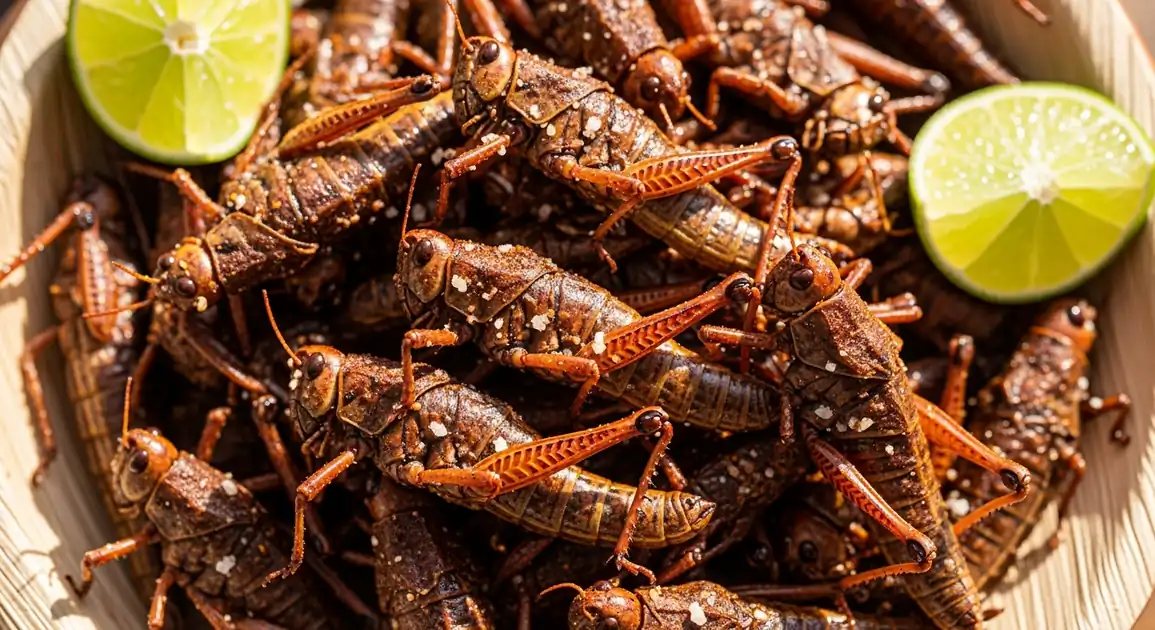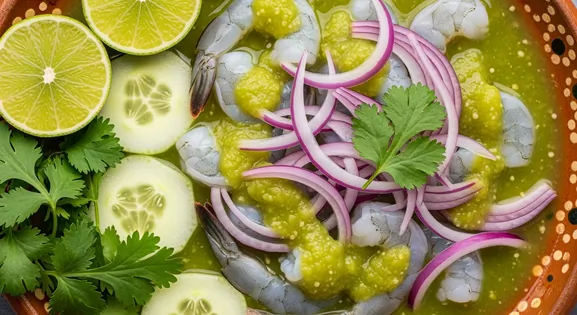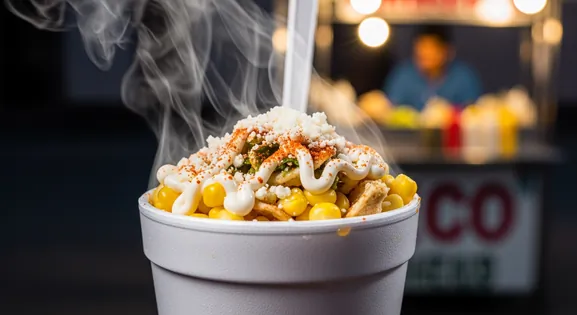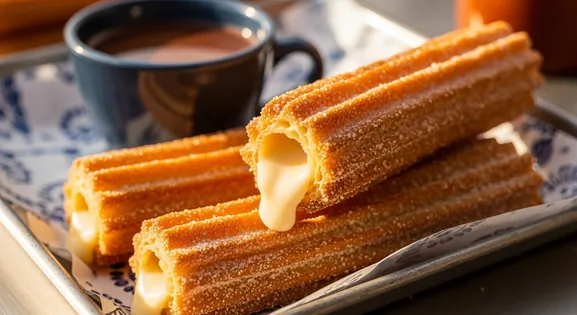Chapulines (Toasted Grasshoppers) in Mexico City
Chapulines

Chapulines (Toasted Grasshoppers): A Local Culinary Staple
Stepping into Mexico City, you'll quickly realize its culinary scene embraces flavors from across Mexico. Chapulines, those iconic Oaxacan grasshoppers, have found a vibrant home here, transforming from a simple market snack into a gourmet ingredient. Discover where to savor these crunchy, tangy delights.
New to Chapulines (Toasted Grasshoppers)? Learn all about its history in our complete guide.
The Role of Chapulines (Toasted Grasshoppers) in Local Culture
Local Significance
In Mexico City, chapulines represent both a connection to traditional Mexican cuisine and the capital's role as a showcase for regional foods from across the country. They've been embraced as part of Mexico's gastronomic heritage.
Eating Customs
- In markets, eaten as a snack with fresh lime.
- In restaurants, often incorporated into guacamole or as taco toppings.
- In mezcalerías, served as the traditional accompaniment to mezcal flights.
Local Styles of Chapulines (Toasted Grasshoppers)
Gourmet Chapulines
Mexico City restaurants often create upscale versions with premium ingredients or unique preparation methods, such as being seasoned with artisanal salts or exotic chiles.
Chapulines in Contemporary Cuisine
Innovative uses in dishes like chapulín risotto, tlayudas with chapulines, or even chapulín salt for rimming cocktail glasses, particularly in trendy neighborhoods.
Market-Style Chapulines
Traditional preparation maintaining Oaxacan techniques, typically found in markets and stores specializing in products from southern Mexico.
Key Tips for Enjoying This Dish
For the widest selection and freshest chapulines, especially from specialty vendors, arrive at Mercado de San Juan before 3 PM. Many vendors start packing up later in the afternoon.
Beyond market snacks, many contemporary Mexican restaurants in neighborhoods like Roma and Condesa feature chapulines in innovative dishes. Don't be afraid to try them in tacos, guacamole, or even as a cocktail garnish.
Head to a mezcalería in Coyoacán or Roma Norte. Chapulines are a traditional accompaniment to mezcal, often served with lime and salt. It's a quintessential Mexico City experience.
Top Spots for Chapulines (Toasted Grasshoppers) in Mexico City
Mercado de San Juan
Mexico City's gourmet market featuring stands specializing in insects and exotic foods. The most reliable source for quality chapulines.
Central section of the market, Specialized Oaxacan products stands
10 AM - 5 PM daily, best selection before 3 PM
La Merced Market
Traditional large market with several vendors selling chapulines, typically at better prices than tourist areas.
Dried goods section, Oaxacan products area
Morning to Afternoon
Centro Histórico
Tourist-oriented vendors near main attractions sometimes sell small portions of chapulines as a novelty food.
Streets surrounding Zócalo, Near Templo Mayor
Afternoon, Early Evening
Condesa and Roma
Trendy neighborhoods where upscale restaurants and mezcalerías serve creative dishes featuring chapulines.
Mezcal bars, Contemporary Mexican restaurants
Evening (7 PM - 11 PM)
Vendor Tips
- In Mexico City, ask if chapulines are from Oaxaca, as they're typically transported from there.
- At markets, observe if the vendor keeps them covered and how they handle them.
- Specialty vendors in Mercado de San Juan often have the best quality and knowledge.
An Authenticity Guide
What to Look For
-
Vendors in established markets known for Oaxacan products (e.g., Mercado de San Juan, Mercado de Coyoacán)
More likely to source quality chapulines compared to random street vendors.
-
Completely dry and crispy texture
Essential for safety; Mexico City's humidity can affect storage, so ensure they are not damp.
-
Uniform reddish-brown color, indicating proper toasting and seasoning
Look for a consistent reddish-brown hue, which signifies they have been properly toasted and seasoned. Avoid batches that appear overly dark or pale.
-
Sealed bags or well-covered containers
Offers protection from dust and humidity in the urban environment.
What to avoid
-
Open piles exposed to dust and city air
Avoid chapulines displayed in open piles, especially in busy market environments, as they are highly susceptible to dust and airborne contaminants.
-
Chapulines that feel soft or damp
Indicates improper toasting or moisture absorption, a safety concern.
-
Very cheap chapulines from unknown sources
Be wary of unusually low prices or vendors who cannot explain the origin of their chapulines, as this might signal lower quality or less hygienic preparation.
Know Before You Go
Dietary Information
Important Note for Travelers: Your safety is our priority. Below are the common allergens associated with the traditional preparation of this dish. However, recipes and ingredients can vary significantly between establishments. Always confirm all ingredients directly with the food vendor before ordering, especially if you have a severe allergy.
Potential Allergens
Dietary Suitability
Price Guide
Budget Tips
- Markets like Mercado de San Juan offer the best value, typically 30-60 MXN for a small portion.
- Prices increase significantly in upscale restaurants where they may be used as garnishes or in fusion dishes (100-200 MXN).
- Markets in more touristic areas like Centro Histórico typically charge 20-30% more than local neighborhood markets.
- Specialty food stores in upscale neighborhoods like Polanco or Condesa charge premium prices.
Serving & Seasonality
In markets, sold by weight in plastic bags. In restaurants, served in small clay dishes (molcajetes), as taco toppings, or incorporated into contemporary Mexican dishes. Often garnished with lime wedges.Best Times to Enjoy
- Morning to Afternoon: Markets like Mercado de San Juan and La Merced are best visited from late morning to afternoon for the freshest selections.
- Evening: Restaurants and mezcalerías featuring chapulines as appetizers or in creative dishes are busiest in the evening.
Seasonal Availability
Available year-round in Mexico City, with slightly better quality during summer months (rainy season in Oaxaca).
Ordering Like a Local
When ordering chapulines in Mexico City, especially at markets, ask for a small sample ('¿Puedo probar?') to check freshness and seasoning. Specify if you prefer them with or without chile and lime ('con chile y limón' or 'sin chile y limón'). In restaurants, they're often part of a dish, so inquire about the preparation. Don't hesitate to ask about their origin; Oaxacan chapulines are highly prized. Embrace the experience – it's a unique part of Mexican gastronomy.
Step-by-Step Guides
Buying Quality Oaxacan Chapulines in Mexico City
Learn how to confidently select the best Oaxacan chapulines in Mexico City's bustling markets, ensuring freshness and authentic flavor for your culinary adventures.
- Head to markets famous for regional goods, like Mercado de San Juan (exotic foods section) or Coyoacán market.
- Look for vendors specializing in Oaxacan products (cheese, mole, chapulines).
- Assess the chapulines visually: check for dryness, uniform color, and cleanliness.
- Ask if you can try one ('¿Puedo probar uno?') to check crispness and flavor (lime, garlic, chile notes).
- Buy in sealed bags or request a freshly packed portion if buying from an open container.
Using Chapulines from CDMX Markets
Discover versatile ways to enjoy chapulines purchased from Mexico City's markets, from traditional snacks to innovative culinary applications in your own kitchen.
- Enjoy them as a snack ('botana') with lime, often sold seasoned ('con chile y limón').
- Add them to guacamole for texture and flavor, a popular preparation in many CDMX restaurants.
- Use them as a topping for tacos, tlayudas (if available), or even salads.
- Incorporate them into dishes at home, adding a crunchy, savory element.
- Start with a small amount if trying for the first time to accustom your palate to the unique flavor.
Our Commitment to Quality
At Tasteplorers, our mission is to provide the most accurate and useful travel information in the world. To achieve this, all content on this site is created through our unique editorial framework. We utilize leading AI research tools, guided by our proprietary prompts, and a multi-stage validation process. This entire system is overseen by our editorial team to ensure everything we publish meets our high standards for accuracy, cultural nuance, and practical value for travelers.
Learn more about our Editorial Process and our Mission.
Explore regions
Europe
Discover Europe's diverse culinary landscape, from Mediterranean flavors to hearty Alpine fare. Learn to navigate markets, decode menus, and eat like a local.
Latin America & Caribbean
Discover the vibrant cuisines of Latin America & the Caribbean. Our expert guide covers everything from Mexican street food to Peruvian ceviche and market tips.
Oceania
Explore Oceania's diverse food scene. Learn about Polynesian earth ovens, Fijian feasts, and the vibrant café culture of Australia and New Zealand.
Southeast Asia
Explore Southeast Asia's diverse food cultures from Thailand to Vietnam. Get expert tips on navigating spice levels, choosing quality vendors, and understanding the rich traditions of the region.




